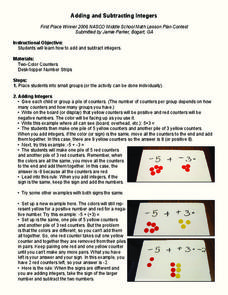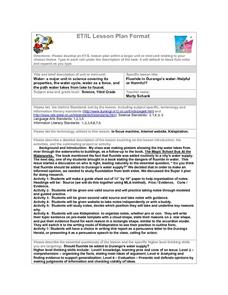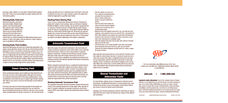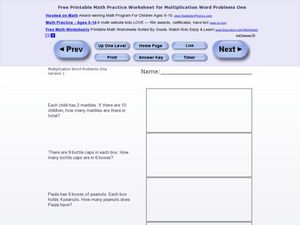Curated OER
Landscape
Learners create a landscape or cityscape. In this landscape lesson, students discover the definition of a landscape and describe various examples. Learners choose three images and write "postcards" from each of the three...
Curated OER
Weapons Of War: The Monitor
Students investigate the building of the first warships of the Civil War. They conduct research using a variety of resources. Students compare and contrast two battleships of the era using a graphic organizer. They also compose a journal...
Curated OER
Easy Crossword
In this literacy worksheet, students find the terms that would fit the crossword puzzle that covers a variety of subject areas including addition, science, and communication.
Curated OER
Basic Mapping Skills
Establish and study the parts of a map with your class and, then they will work in small groups to create their own detailed map, including a legend. There are specific instructions to follow on what needs to be included.
Curated OER
Adding and Subtracting Integers
Students explore how to add and subtract integers. For this integer lesson students are broken into groups and participate in an activity that helps them investigate how to add and subtract integers.
Curated OER
Bean toss
Students arrive at a verifiable rule, or set of rules, to handle all addition situations with signed numbers.
Curated OER
Speed + Graphing = Winners!
Fifth graders take addition timed tests every day for a two week period. Using the data from the timed tests, they create a bar graph using Microsoft Excel computer software, a personal bar graph using graph paper and colored pencils,...
Curated OER
Comparing Asian and Impressionist Landscapes
Students draw on their knowledge of Impressionist and Asian landscapes to reflect on the differences found in the two genres of landscape painting.
Curated OER
Scavenger Hunt
Students study a research telescope to obtain quantitative information about these objects. They use the SkyServer Navigation Tool to identify objects and record celestial coordinates. In addition, they associate star brightness and...
Curated OER
More or Less? Mouse or Elephant?
Second graders have fun predicting the relative sizes of answers to addition and subtraction problems using their animal friends. When the lesson is finished, give each student two cookies for a job well done.
Curated OER
Where Does Radon Come From?
Students discuss the differences between the three types of rocks and how radon can escape from the rocks themselves. They analyze other sources of radon in the environment. They work together to complete an activity and worksheet.
Curated OER
Mapping Seamounts in the Gulf of Alaska
Students describe major topographic features on the Patton Seamount, and interpret two-dimensional topographic data. They create three-dimensional models of landforms from two-dimensional topographic data.
Curated OER
Mother Earth - Father Sky
Third graders research and write about Cyrus Dillan. They explain one of Dillan's sculptures. Students locate six constellations and two planets. They research and write about the daily life of the Pawnee.
Curated OER
An Opening Time Line Project
Students create a time line of their life starting at birth and each year after that up to their current age. They write and illustrate one important thing for each year, and place their time lines on poster board.
Curated OER
Disappearing Magic Factors
Students identify, through the number of rows and columns, the factors related to the product. In turn, they also discover how to find the missing factor, which is part of the fact family for that product.
Curated OER
Using the Correct Vocabulary to Solve Problems
Third graders examine the vocabulary and strategies to be used with addition, subtraction, and multiplication word and story problems. They observe the teacher solve a variety of problems, then write and illustrate their own original...
Curated OER
Underwater Picture of the Hudson River Estuary
Young scholars identify important aspects of water quality such as slainity and turbidity. They test two of the water quality parameters and determine the quality of the water. In addition, they construct two sets of graphs based on data...
Curated OER
Moons
Students practice rote counting to 20. After a lecture about the planets and the moons that surround them, they identify the number of moons surrounding various planets. Students compare and contrast the quantity of moons surrounding...
Curated OER
Narrating in the Past Tense
Learners describe a picture of themselves from age 5-6 using the past tense in French. They review and apply the rules of using the two past tenses.
Curated OER
Fluoride in Durango's Water-Helpful or Harmful?
Third graders complete several activities in their quest to find out about the addition of fluoride to city water. First, they create a guide sheet to help organize notes. The next two steps involve taking notes through guided practice....
TryEngineering
Data Representation: Millions of Colors
How many colors do you know? The lesson teaches scholars how digital devices use binary and hexadecimal representations to store colors. They learn how millions of colors are available on these devices.
AAA
Oil, Fuel, Coolant & Fluids
Although designed for vocational and auto shop classes, this image of a pamphlet contains everything anyone would need to know about automobile engine the fluids, how to check them, and when to replace them.
Curated OER
Multiplication Word Problems 1 Version 1
In this multiplication worksheet, 2nd graders read and solve 6 word problems in which single digits are multiplied. There is a box next to each problem for students to show their work.
Curated OER
Nurturing Green Thumbs at School
Incorporating a school garden into the curriculum cultivates many benefits.

























